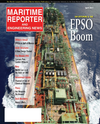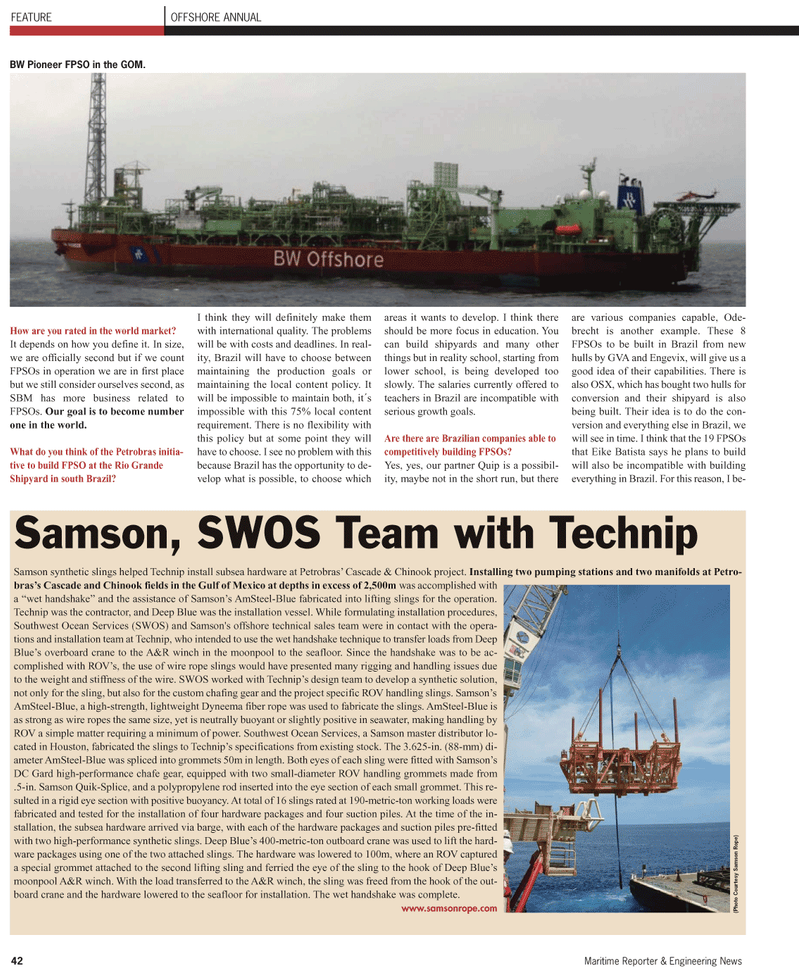
Page 42: of Maritime Reporter Magazine (April 2011)
Offshore Annual
Read this page in Pdf, Flash or Html5 edition of April 2011 Maritime Reporter Magazine
42 Maritime Reporter & Engineering News
FEATURE OFFSHORE ANNUAL
Samson, SWOS Team with Technip
Samson synthetic slings helped Technip install subsea hardware at Petrobras’ Cascade & Chinook project. Installing two pumping stations and two manifolds at Petro- bras’s Cascade and Chinook fields in the Gulf of Mexico at depths in excess of 2,500m was accomplished with a “wet handshake” and the assistance of Samson’s AmSteel-Blue fabricated into lifting slings for the operation.
Technip was the contractor, and Deep Blue was the installation vessel. While formulating installation procedures,
Southwest Ocean Services (SWOS) and Samson's offshore technical sales team were in contact with the opera- tions and installation team at Technip, who intended to use the wet handshake technique to transfer loads from Deep
Blue’s overboard crane to the A&R winch in the moonpool to the seafloor. Since the handshake was to be ac- complished with ROV’s, the use of wire rope slings would have presented many rigging and handling issues due to the weight and stiffness of the wire. SWOS worked with Technip’s design team to develop a synthetic solution, not only for the sling, but also for the custom chafing gear and the project specific ROV handling slings. Samson’s
AmSteel-Blue, a high-strength, lightweight Dyneema fiber rope was used to fabricate the slings. AmSteel-Blue is as strong as wire ropes the same size, yet is neutrally buoyant or slightly positive in seawater, making handling by
ROV a simple matter requiring a minimum of power. Southwest Ocean Services, a Samson master distributor lo- cated in Houston, fabricated the slings to Technip’s specifications from existing stock. The 3.625-in. (88-mm) di- ameter AmSteel-Blue was spliced into grommets 50m in length. Both eyes of each sling were fitted with Samson’s
DC Gard high-performance chafe gear, equipped with two small-diameter ROV handling grommets made from .5-in. Samson Quik-Splice, and a polypropylene rod inserted into the eye section of each small grommet. This re- sulted in a rigid eye section with positive buoyancy. At total of 16 slings rated at 190-metric-ton working loads were fabricated and tested for the installation of four hardware packages and four suction piles. At the time of the in- stallation, the subsea hardware arrived via barge, with each of the hardware packages and suction piles pre-fitted with two high-performance synthetic slings. Deep Blue’s 400-metric-ton outboard crane was used to lift the hard- ware packages using one of the two attached slings. The hardware was lowered to 100m, where an ROV captured a special grommet attached to the second lifting sling and ferried the eye of the sling to the hook of Deep Blue’s moonpool A&R winch. With the load transferred to the A&R winch, the sling was freed from the hook of the out- board crane and the hardware lowered to the seafloor for installation. The wet handshake was complete. www.samsonrope.com (Photo Cour tesy Samson Rope)
How are you rated in the world market?
It depends on how you define it. In size, we are officially second but if we count
FPSOs in operation we are in first place but we still consider ourselves second, as
SBM has more business related to
FPSOs. Our goal is to become number one in the world.
What do you think of the Petrobras initia- tive to build FPSO at the Rio Grande
Shipyard in south Brazil?
I think they will definitely make them with international quality. The problems will be with costs and deadlines. In real- ity, Brazil will have to choose between maintaining the production goals or maintaining the local content policy. It will be impossible to maintain both, it´s impossible with this 75% local content requirement. There is no flexibility with this policy but at some point they will have to choose. I see no problem with this because Brazil has the opportunity to de- velop what is possible, to choose which areas it wants to develop. I think there should be more focus in education. You can build shipyards and many other things but in reality school, starting from lower school, is being developed too slowly. The salaries currently offered to teachers in Brazil are incompatible with serious growth goals.
Are there are Brazilian companies able to competitively building FPSOs?
Yes, yes, our partner Quip is a possibil- ity, maybe not in the short run, but there are various companies capable, Ode- brecht is another example. These 8
FPSOs to be built in Brazil from new hulls by GVA and Engevix, will give us a good idea of their capabilities. There is also OSX, which has bought two hulls for conversion and their shipyard is also being built. Their idea is to do the con- version and everything else in Brazil, we will see in time. I think that the 19 FPSOs that Eike Batista says he plans to build will also be incompatible with building everything in Brazil. For this reason, I be-
BW Pioneer FPSO in the GOM.

 41
41

 43
43
